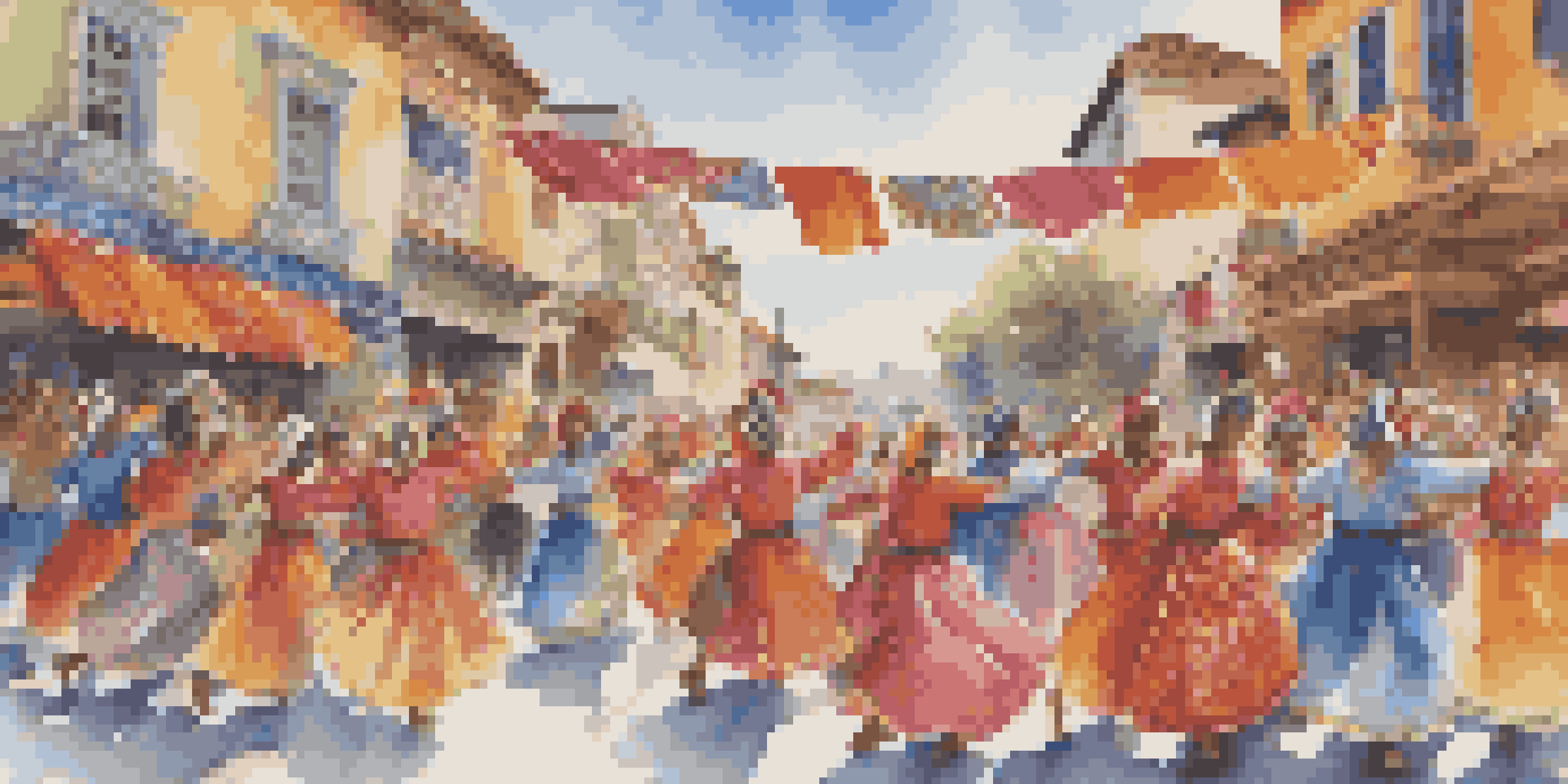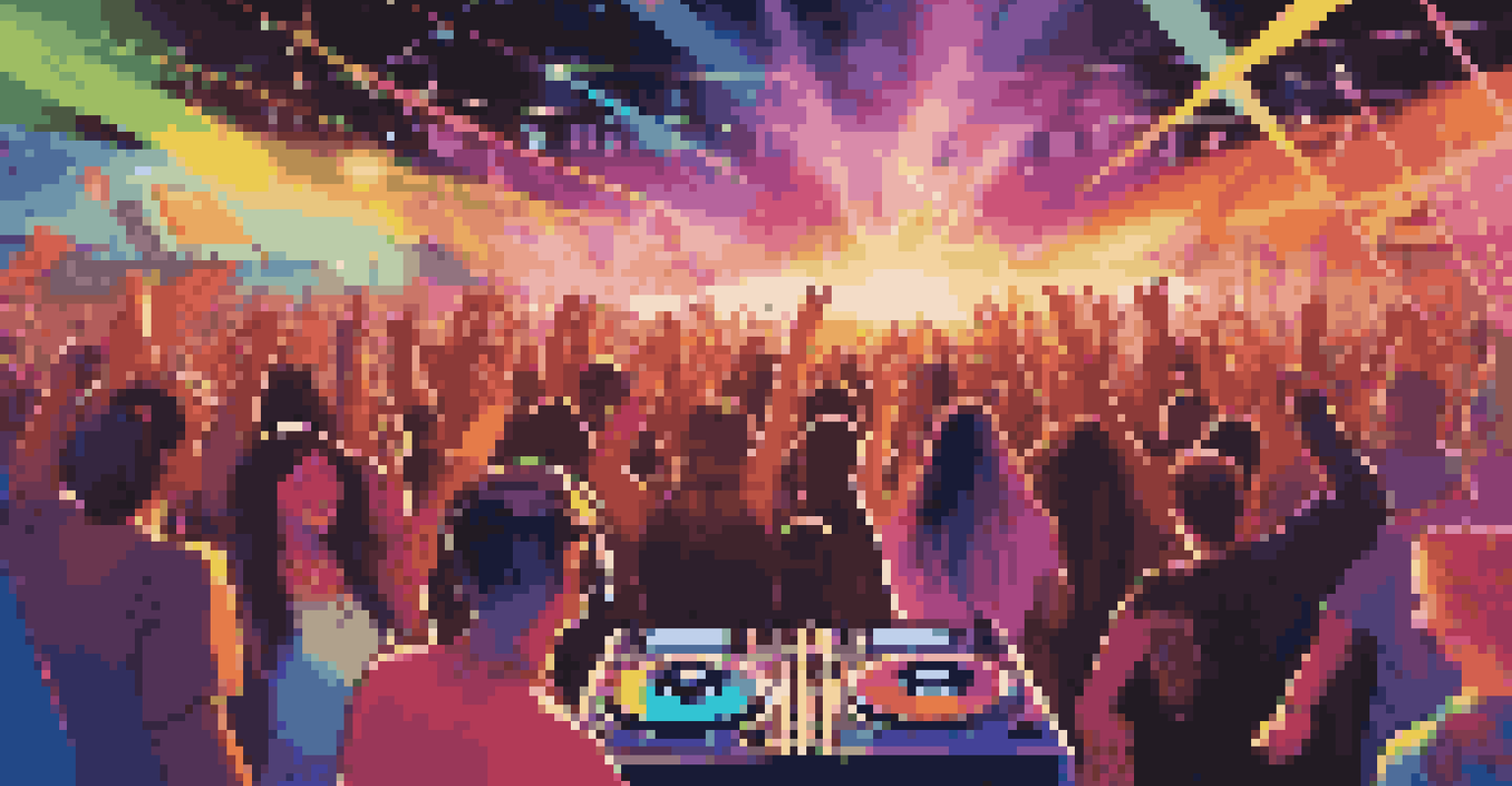The Interconnection of Music and Dance: A Historical Perspective

The Origins of Music and Dance in Human Culture
From the earliest days of humanity, music and dance have been intertwined, serving as vital forms of expression and communication. Archaeological findings suggest that primitive tribes used rhythmic sounds and movements to celebrate important events and rituals. This primal bond highlights how music and dance have always been essential to social cohesion and cultural identity.
Music is the shorthand of emotion.
In many ancient cultures, such as those in Africa and Asia, music and dance were not merely entertainment but integral parts of spiritual ceremonies. For instance, drumming and dancing during rituals helped to connect communities with their deities and ancestors. These practices laid the groundwork for the complex relationship we see between music and dance throughout history.
As societies evolved, so did the forms of music and dance, yet their interconnection remained strong. The rhythmic patterns of music often inspired specific dance movements, creating a symbiotic relationship that continues to flourish in various cultures around the world.
The Role of Music in Traditional Dance Forms
Traditional dance forms across the globe often rely on music to convey cultural narratives and histories. For example, in Indian classical dance, intricate footwork and hand gestures are synchronized with melodic musical rhythms, telling stories of gods and folklore. This seamless blend showcases how music acts as a storytelling medium, enhancing the emotional depth of the dance.

In many indigenous cultures, music is vital in preserving oral histories through dance. The rhythms and melodies serve as mnemonic devices, helping dancers remember and convey their ancestral stories. This practice underscores how music not only complements dance but also enriches cultural heritage.
Music and Dance as Cultural Pillars
From ancient rituals to modern celebrations, music and dance have always been essential to expressing cultural identity and social cohesion.
Moreover, traditional dances often evolve with the music of their time, reflecting societal changes. For instance, as jazz emerged in the early 20th century, it influenced various dance styles like the Charleston and swing, illustrating how contemporary music can rejuvenate and transform traditional dance forms.
The Influence of Cultural Exchange on Dance and Music
Cultural exchange has played a pivotal role in shaping the relationship between music and dance throughout history. Trade routes and colonization brought diverse musical styles into contact, leading to hybrid dances that combined elements from different traditions. This melting pot of influences often results in vibrant and unique dance forms that celebrate the fusion of cultures.
Dance is the hidden language of the soul.
For example, the tango emerged from the blending of African, European, and indigenous influences in Argentina. The passionate music of the tango, combined with its intricate dance movements, tells a story of longing and connection, highlighting how cultural exchange can give birth to entirely new art forms.
Furthermore, globalization in the modern era has accelerated this exchange, allowing dancers and musicians from various backgrounds to collaborate and innovate. As a result, the dance floor has become a global stage where different rhythms and movements converge, enriching the artistic landscape.
The Evolution of Dance Music Genres
As music genres have evolved, they have continually influenced dance styles. The rise of rock and roll in the 1950s gave birth to energetic dance crazes like the twist, showcasing how new sounds can inspire spontaneous movement. This trend illustrates the dynamic relationship between music's evolution and the development of dance.
Moreover, the emergence of electronic dance music (EDM) has transformed the nightlife scene, creating new genres of dance like rave and shuffle. The pulsating beats and synthesized sounds have led to a whole new way of experiencing dance, where the music drives the movement in unprecedented ways.
Cultural Exchange Shapes Art Forms
The blending of diverse musical styles through cultural exchange has led to the creation of unique dance forms that celebrate a fusion of traditions.
This ongoing evolution demonstrates that as music continues to grow and diversify, so too does the dance that springs from it. The connection between the two art forms remains a vibrant dialogue that reflects the changing tastes and cultural landscapes of society.
The Psychological Connection Between Music and Dance
Research shows that music and dance are deeply connected on a psychological level, influencing mood and behavior. The rhythms and melodies of music can evoke emotions that inspire movement, leading to spontaneous dance. This psychological response highlights why many people feel compelled to dance when they hear their favorite songs.
Additionally, studies suggest that dancing to music releases endorphins, promoting feelings of happiness and reducing stress. This effect creates a positive feedback loop where the joy of music leads to dancing, which in turn enhances the overall experience of the music. It's a beautiful cycle of expression and emotion.
This connection is evident in social settings, where music fosters a sense of community and belonging through dance. Whether at a wedding or a concert, the shared experience of moving to music creates bonds among participants, demonstrating how intertwined music and dance are in our collective consciousness.
The Impact of Technology on Dance and Music
Technology has significantly influenced the relationship between music and dance in recent decades. The advent of the internet and social media platforms has made it easier for dance trends to spread rapidly, as seen with viral challenges on platforms like TikTok. These trends showcase how music can inspire new dance moves almost overnight, reflecting a modern twist on traditional forms.
Moreover, advancements in music production have allowed for the creation of entirely new sounds and genres, further altering the dance landscape. Artists can now experiment with different styles and collaborate globally, leading to innovative dance forms that were previously unimaginable. This evolution keeps the music-dance connection fresh and exciting.
Technology Transforms Dance Experience
Advancements in technology and social media have revolutionized how music and dance evolve, allowing new trends to spread rapidly and inspire innovative art forms.
As technology continues to evolve, it will undoubtedly further shape how we create, share, and experience music and dance together. The future holds endless possibilities for this dynamic relationship, making it an exciting time for artists and audiences alike.
The Future of Music and Dance: A Collaborative Outlook
Looking ahead, the relationship between music and dance is bound to deepen as we navigate an increasingly interconnected world. Artists from various backgrounds are more likely to collaborate, creating cross-cultural dances that blend diverse musical influences. This trend promises to enrich both art forms, bringing fresh perspectives and styles to the forefront.
Additionally, as society becomes more inclusive and diverse, we can expect to see a wider range of dance forms representing different cultures and experiences. This inclusivity will help preserve traditional dances while also allowing for innovation, ensuring that the music-dance connection remains vibrant and relevant.

Ultimately, the future of music and dance is one of collaboration, creativity, and exploration. By embracing the interconnection of these two art forms, we can continue to celebrate the rich tapestry of human expression that has evolved over centuries.